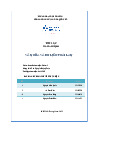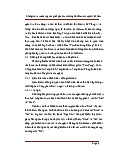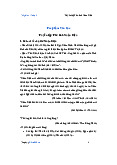



Preview text:
Unit 1: Gerunds and Infinitives Infinitives
An Infinitives is the base form of a verb with to preceding it
A. Use a to-infinitives after the following common verbs: agree, decide, expect,
happen, pretend, promise, manage, tend - He decided to go home
B. Use a to-infinitives after the following common verbs plus their object: advise,
allow, expect, forbid, want, force, tell
- His manager allowed him to go home
C. Use an infinitive without to after the common following verbs plus their object:
have, let, make, feel, see, hear, smell, find - He let Tom go home Gerunds
A gerund is the -ing form of a verb. It is used as a noun
Use an -ing form after the following common verbs: avoid, can’t help, deny, feel like,
give up, imagine, mind, postpone, enjoy, consider - He enjoys drinking coffee
Choosing Between Infinitives and Gerunds
The gerund is always used when a verb is followed by a preposition: admit to,
approve of, argue about, believe in, care about, complain about, concentrate on, confess to
- They apologized for being late
- He dreamed about giving her a ride
The following common verbs allow both a to-infinitive form and an -ing form.
Sentences with either form will have the same meaning, They are: attempt, begin,
continue, hate, like, love, neglect, prefer, regret, stand/ can’t stand, start
- He likes to walk ( Anh ấấy muốấn đi d o ) ạ
- He likes walking ( Anh ấấy thích đi d o ) ạ
The following common verbs allow both a to-Infinitives form and an -ing form.
However, their meanings are different in each case: remember, forget, stop, regret, try
Try + to-V = Cốấ gắấng làm gì đó Try + V-ing = th m ử t th ộ gì đó m ứ i ớ
Mean + to-V = ý định làm gì đó Mean + V-ing = làm luốn Go on + to-V = ng ng l ư àm m t vi ộ c gì đó ệ Go on + V-ing = tiếấp t c ụ Forget + to-V = t ng làm rốồi nh ưở ng th ư t ra là ch ậ a ư
NOTE: The choice of a to-V or an -ing form depends on the meaning Unit 2: Auxiliary Verbs
Auxiliary verbs are used in conjunction with main verbs to show differences in time
and mood. Common auxiliary verbs are: do, have, is, will, shall, may, might, can,
could, must, should, would, used to, need to.
What Follows Auxiliary Verbs?
A. Auxiliary verbs can be followed by a verb ending in -ing or -ed - The boy is flying a kite
- The book was listed as a best seller
- The boy has closed the window
B. Auxiliary verbs can be followed by the basic form of the verb - Paul may arrive tomorrow - Do you like fish?
- I do believe that he is right
Meaning of Key Auxiliary Verbs
1. Will: be willing to, intend to
2. Shall: intend to (formal), have decided to 3. May/Can: be possible to
4. Can/Could/May: be allowed to do
5. Must: be necessary, be logically certain
6. Must/Have to: be required to do
7. Should/ Ought to: be obliged to do
8. Should have/ Could have + P.P ( Past Participle ): was not truth, did not happen
9. Used to/ Would: regularly or repeatedly did in the past
Unit 3: Verb Form and Tense
Present: Simple, Perfect and Progressive
A. Use present simple for routines, habit or things that are always true
NOTE: Present simple is also used instead of the future tense in adverbial clauses led
by : if, the moment, when, as soon as, before, after, etc e.g
B. Use present progressive for a temporary routine or situation
NOTE: Present Progressive can be used to express the future when future time words
are used such as: tonight, tomorrow, next week, etc e.g
C. Use present perfect (have/has -ed) for a situation where things that happened
in the past have a result in the present
NOTE: Present perfect often goes with just, yet, for, since, ever, never, first time,
second time, this week, but it does not go with expressions that definitely refer to the past
Past: Simple, Perfect, and Progressive
A. Use past simple for something that occurred in the past
B. Use past progressive for a temporary routine or situation that happened in the past.
C. Use past perfect for something that happened before a certain point in time in the past
Future: Use of Will and Other Words with Future Meaning
A. Use will for instant decisions
B. Use be going to for established plans
NOTE: When be going to is used in the past tense, it will represent an unfulfilled intention Unit 4: Participial Forms
Forms of Participles: -ing and -ed
A. If a noun modified by a participle is the agent, choose an -ing form
B. If a noun modified by a participle is NOT the agent, choose an -ed form Participle Clauses
A. An -ing form can be used when two things occur at the same time.
B. An -ing form can be used when one action occurs during another action
C. An -ing form clause can be an explaination of its main clause
Unit 5: Comparative and Superlatives Regular Comparison
A. When comparing things, most short adjectives ( one or two syllables ) end in -er/-est. - dark - darker - the darkest - hot - hotter - hottest - happy - happier - happiest
- narrow - narrower - narrowest - scary - scarier - scariest
B. For adjectives with three or more syllables, place more, most, less or least before the adjective
- beautiful - more beautiful - the most beautiful
- expensive - more expensive - the most expensive Irregular Comparison
A few adjectives and adverbs have comparative and superlative form that are
different from the regular form.
- good/well - better - the best
- bad/ badly - worse - the worst - much/ many - more - the most - little - less - the least
- far - farther/ further - the farthest/ the furthest
NOTE: Further is used for greater distance and more of something, while farther is
only used for greater distance. As … As Comparison
A. Only the regular form of an adjective or adverbs come between as and as
B. Put twice, three times, four times, etc before the first as to multiply the size, amount, etc
Modification of Comparatives
Comparatives can be modified by the following words: much, very much, far, a little,
a bit, a lot, any, no, even, still
NOTE: The adverb very cannot modify comparatives Unit 6: Conditionals
Tense in Conditional Sentences
A. To express a true situation in the present/future, use the simple present in the
If - clause and will + simple form in the result clause
B. To express an untrue situation in the present/future, use past tense in the If -
clause and would/could/might + simple form in the result clause
C. To express an untrue situation in the past, use past perfect in the If - clause and
would/could/might have + past participle in the result clause
Tense in As though/ As if…/ I wish…/ It’s time… Clause
A. … as if + S + subjunctive verb: To express an untrue situation, the verb in the As
if clause be subjunctive, as in I/you/she/he/it/they + were or I/you/she/he/it/ they had + past participle
B. Verb forms of the I wish Clause: wish is used when the speaker wants
something to be the opposite to reality or when one makes wishes about the future
C. It’s time that S + verb (Past tense)
Demand/Insist/Require/Vital/Necessary + that + S + verb
Vital - demand - insist - necessary - require - recommend - request - suggest - propose - M c đ ứ quan tr ộ ng gi ọ m dầần t ả trái ừ sang ph i ả




